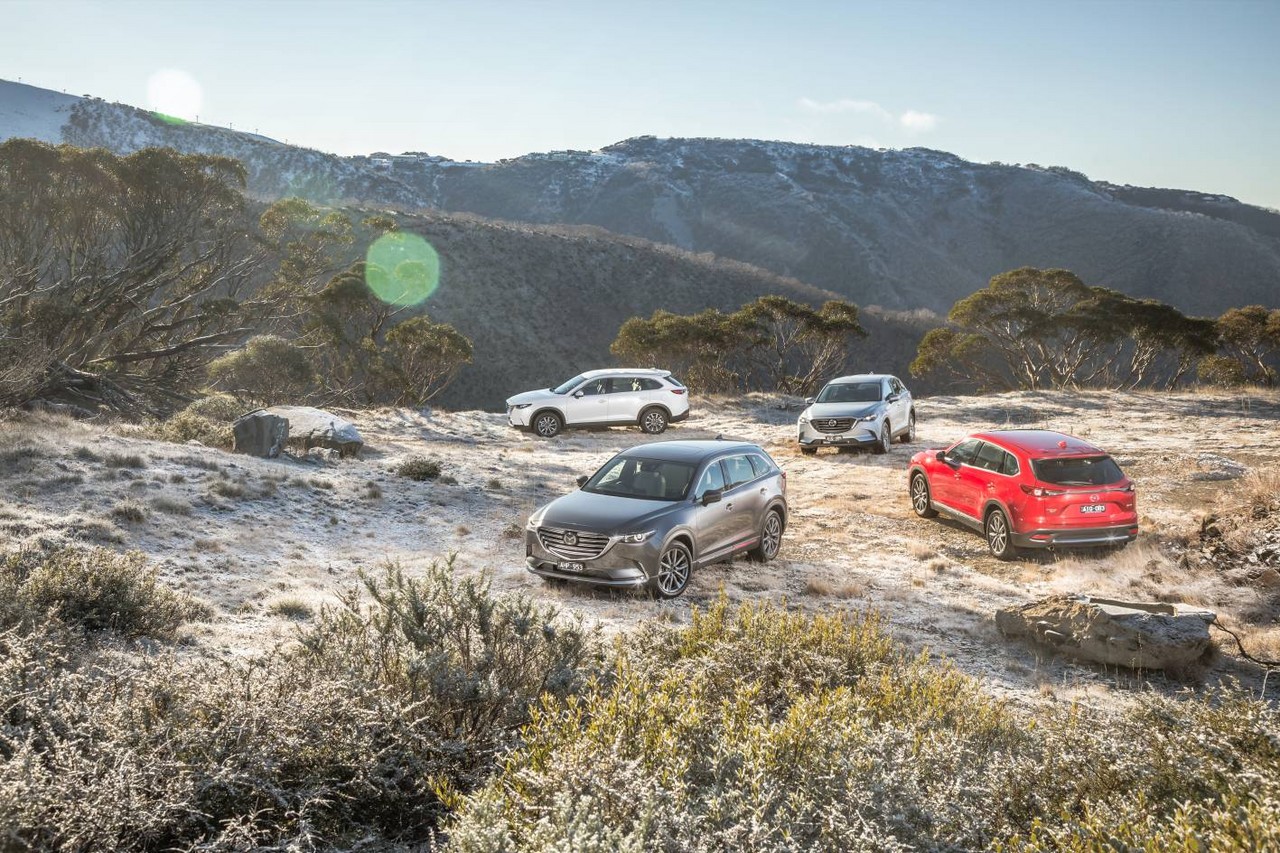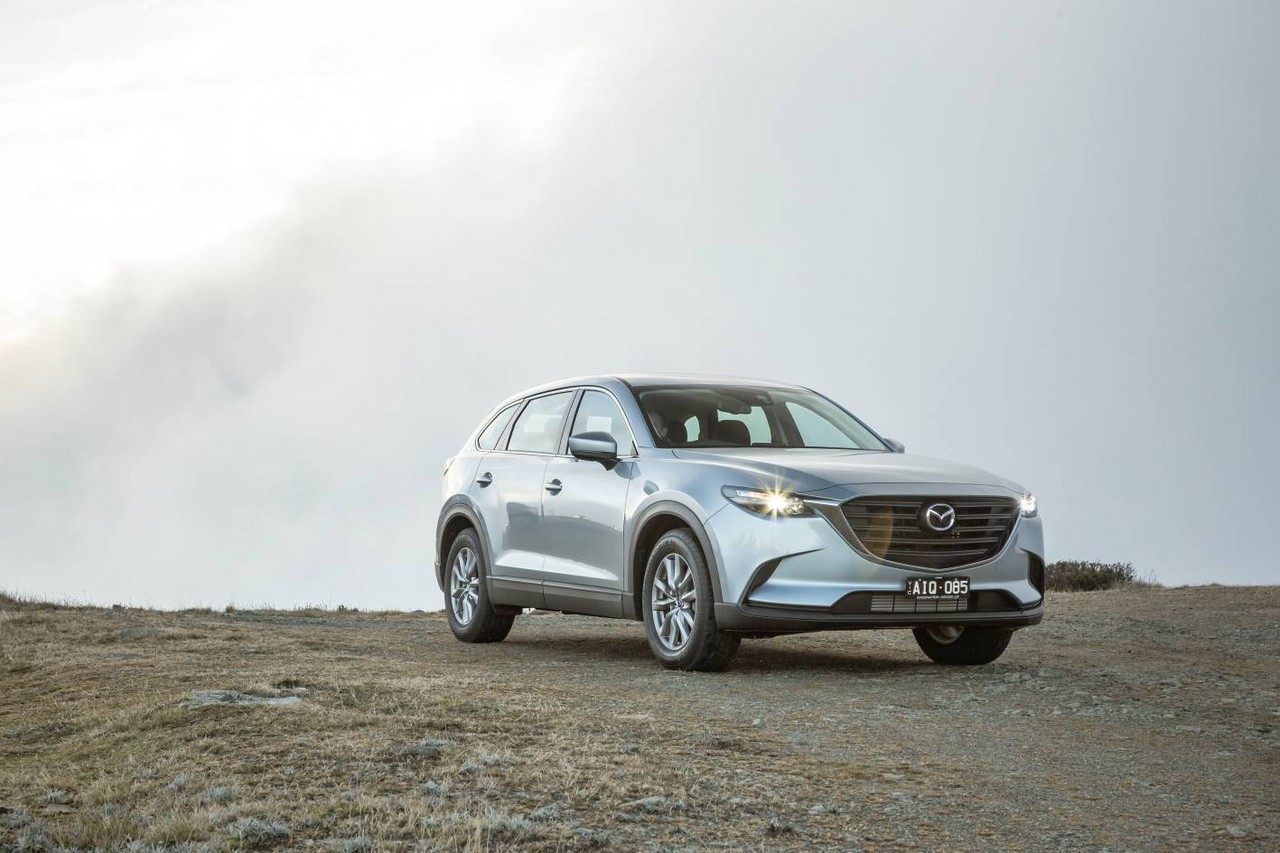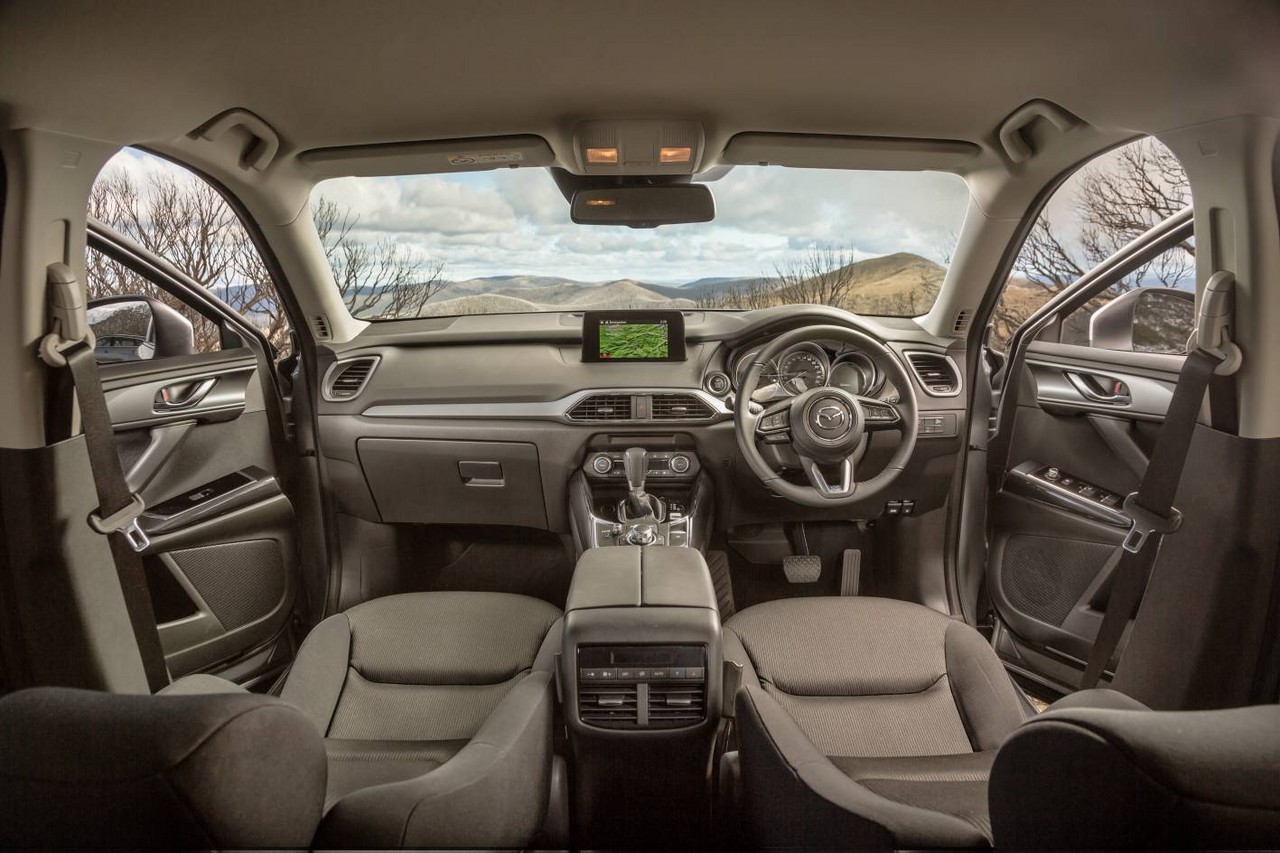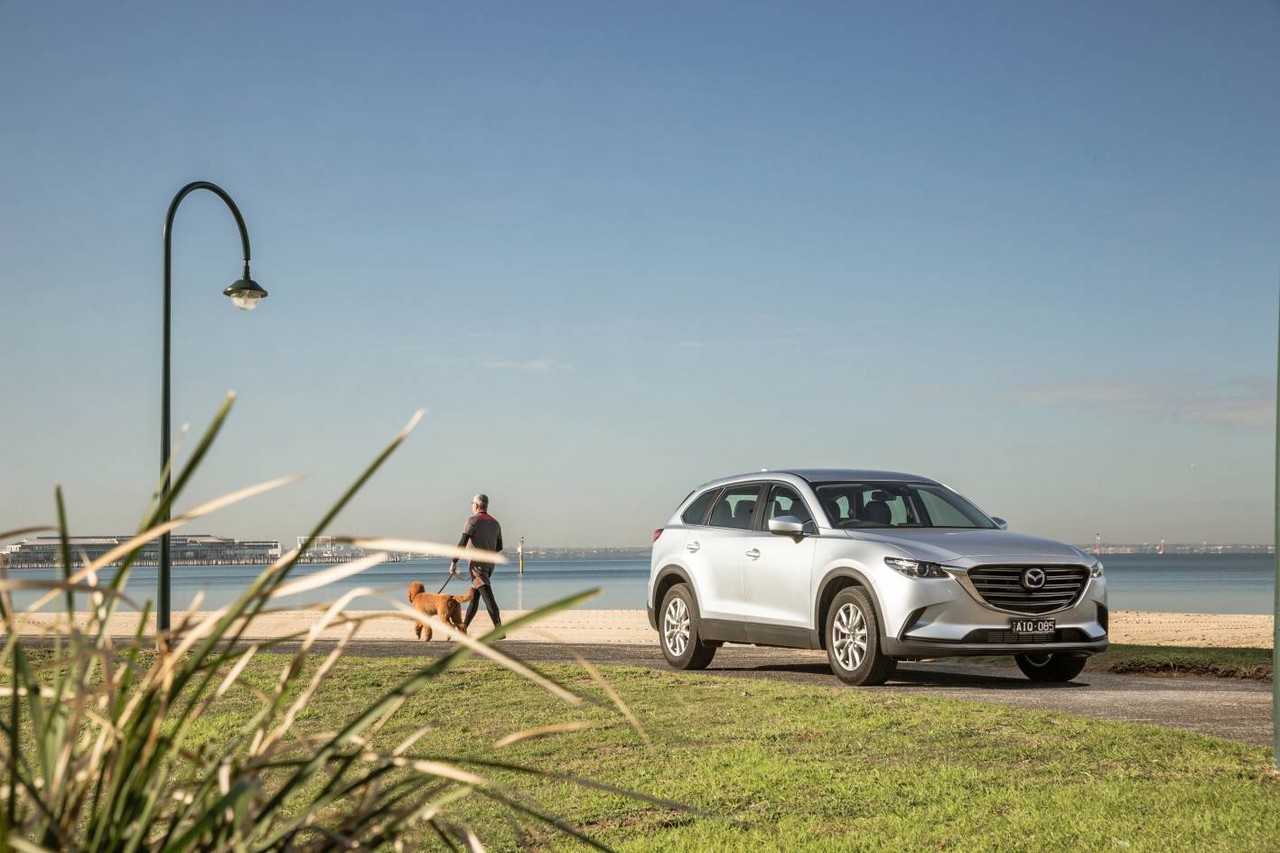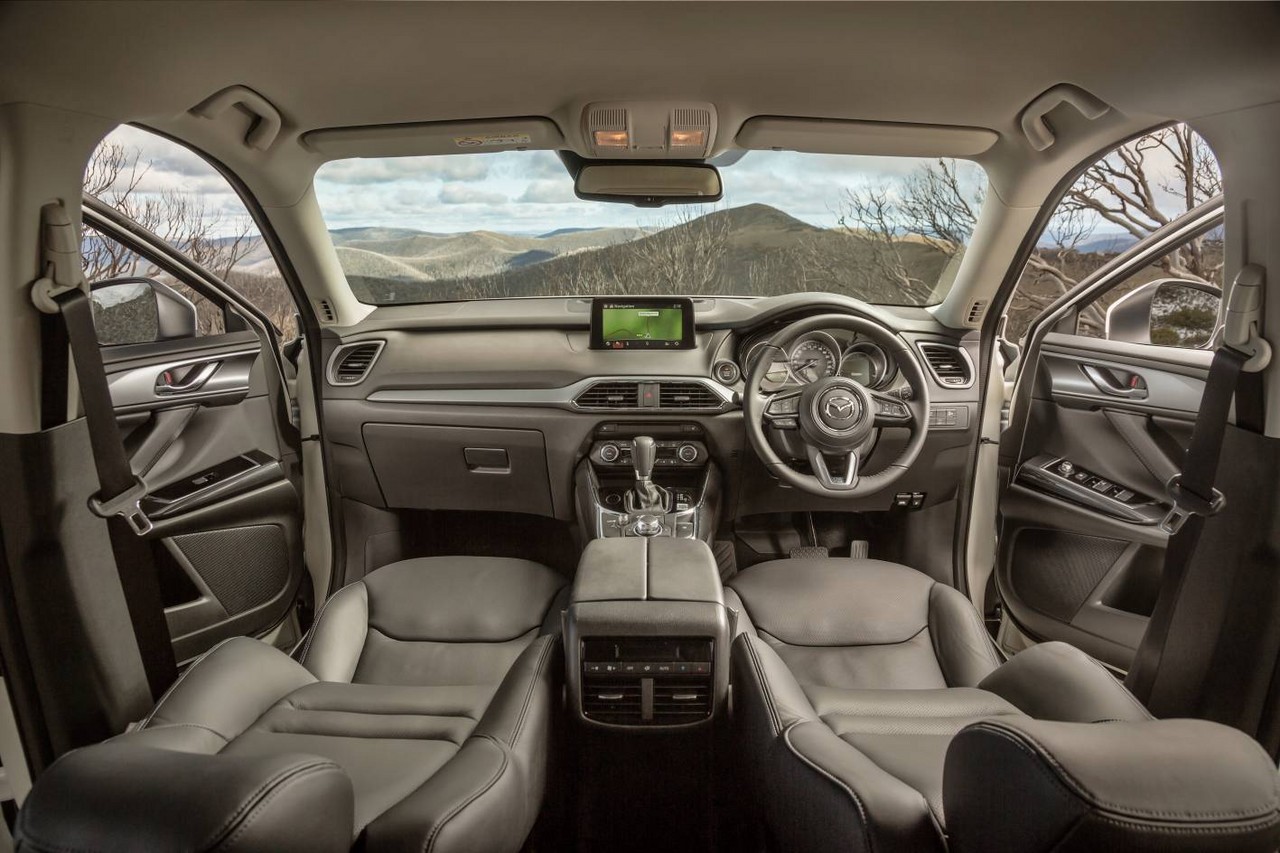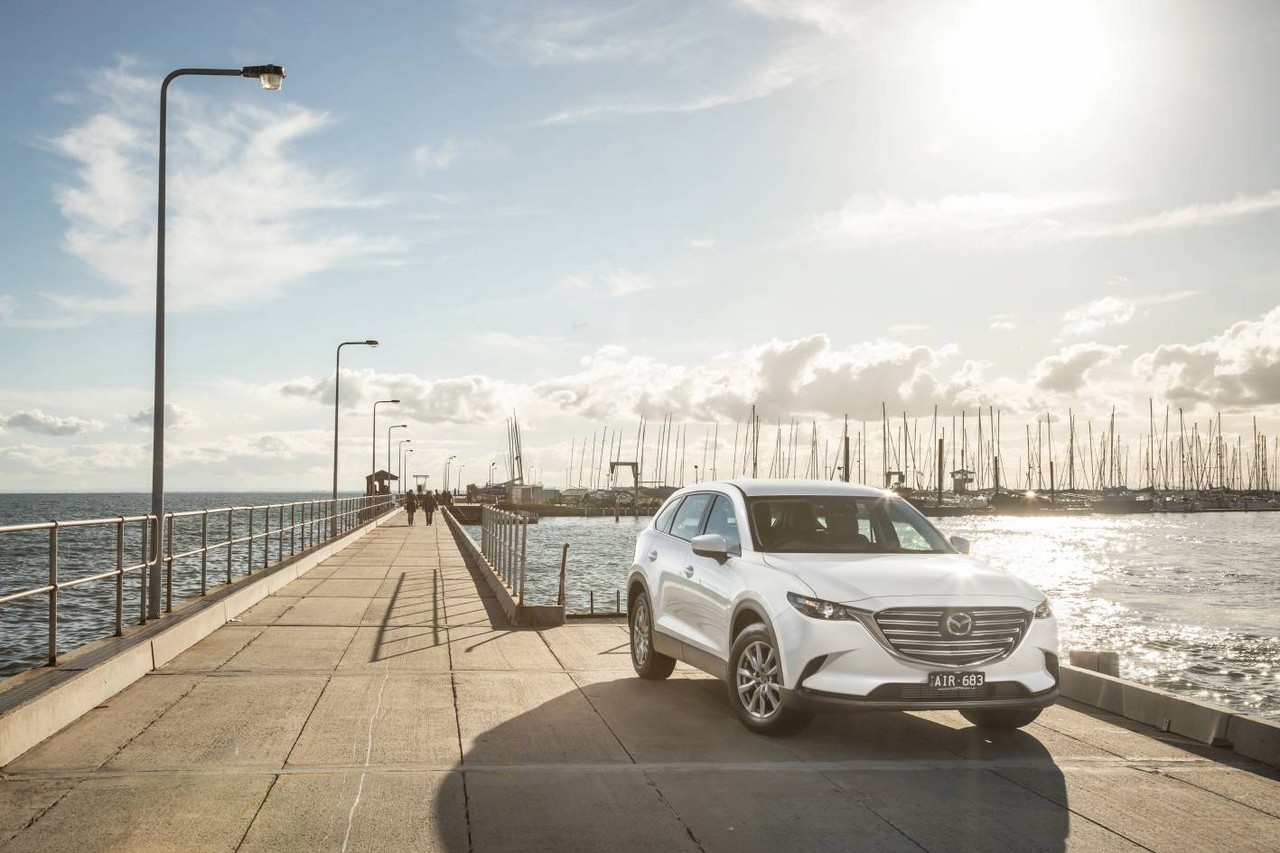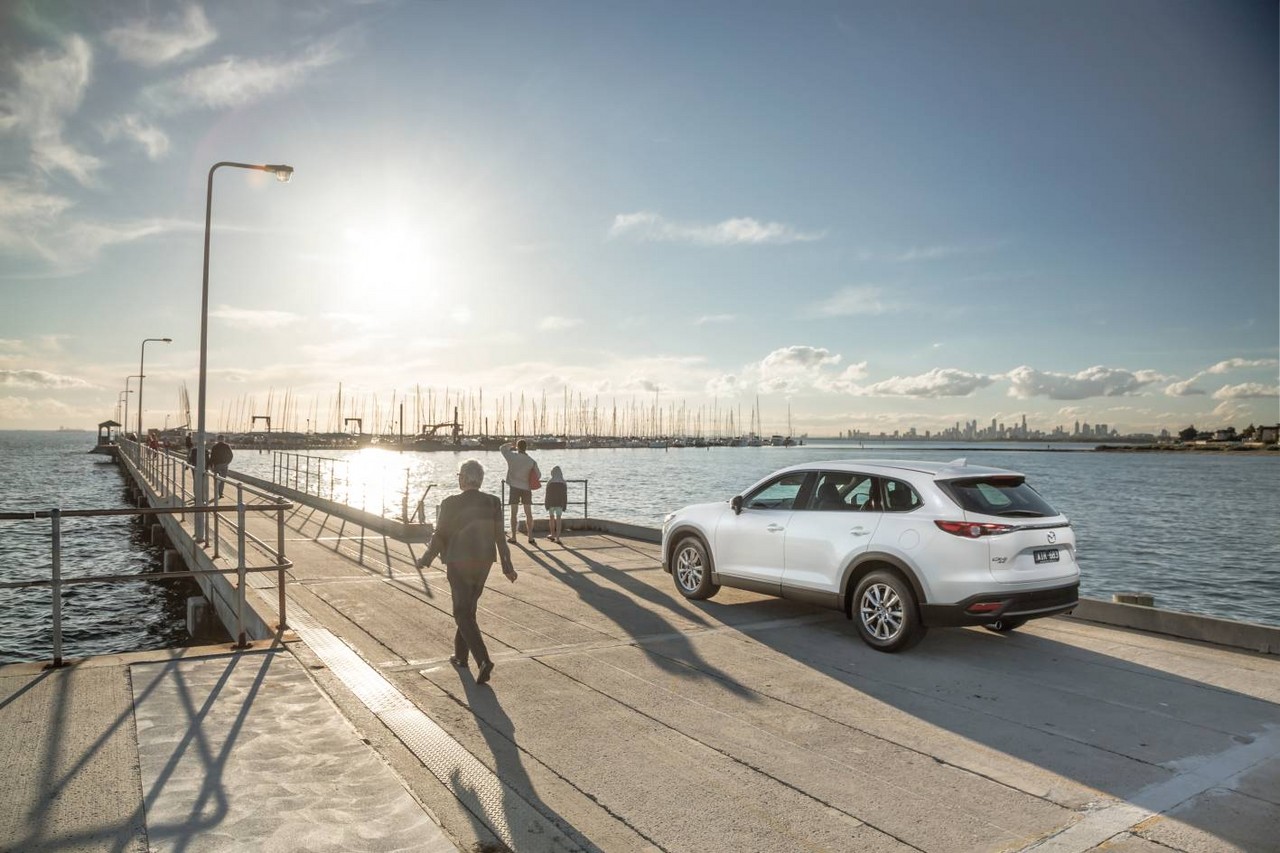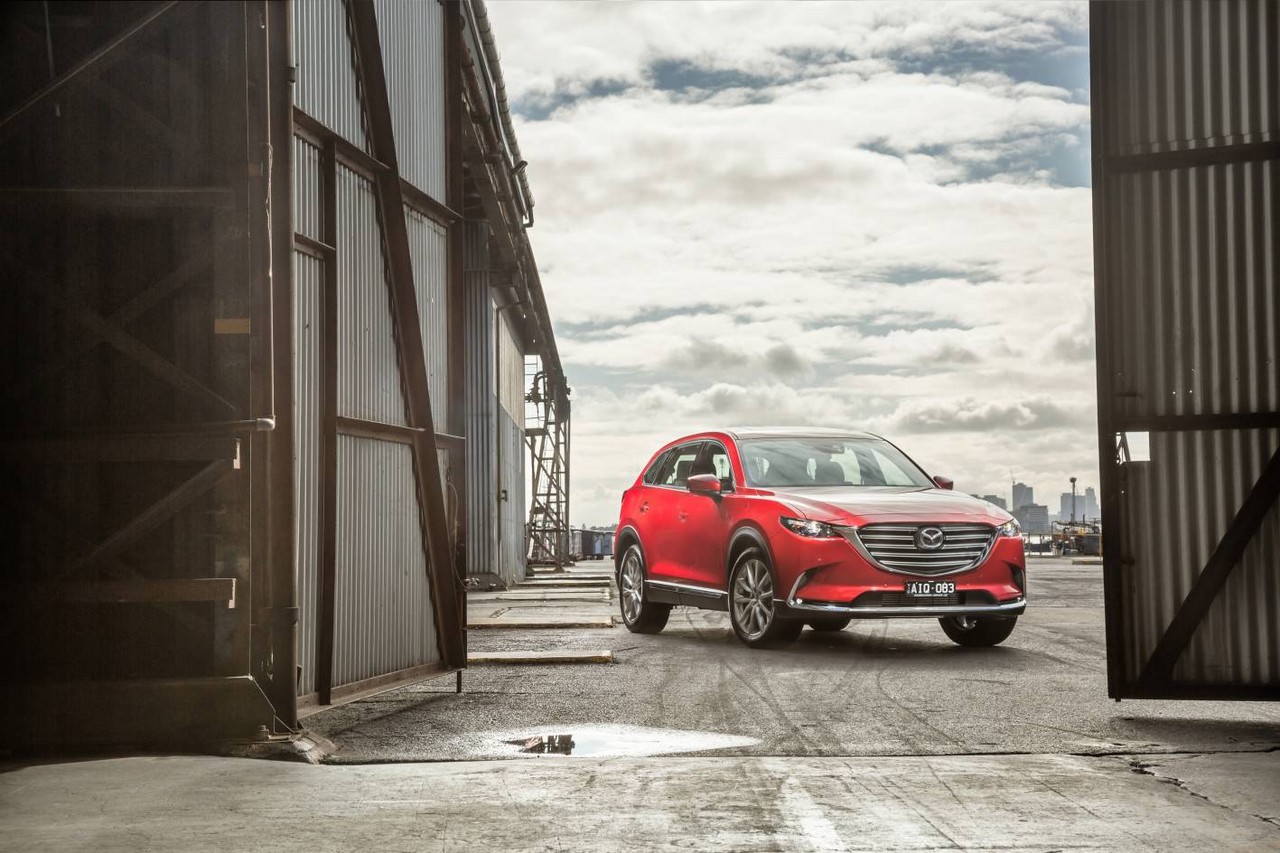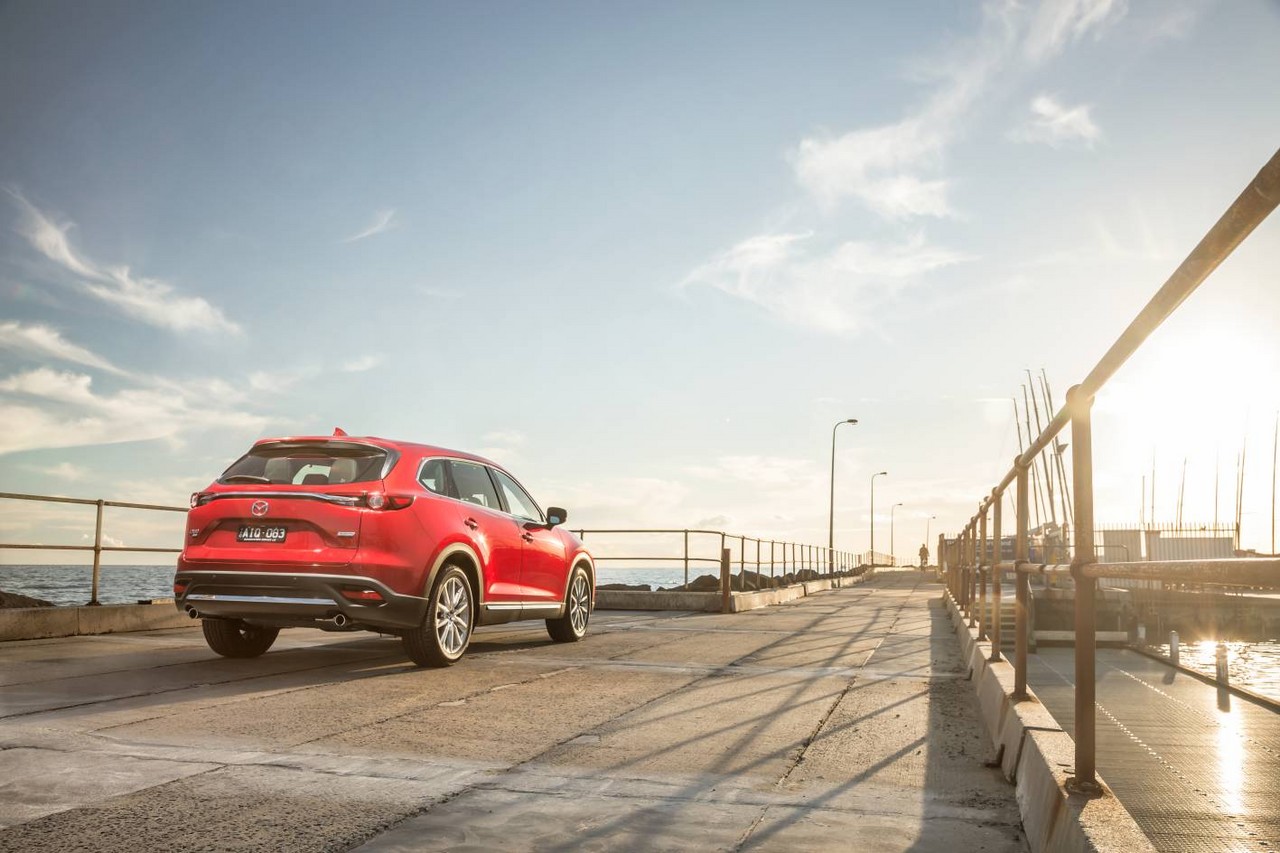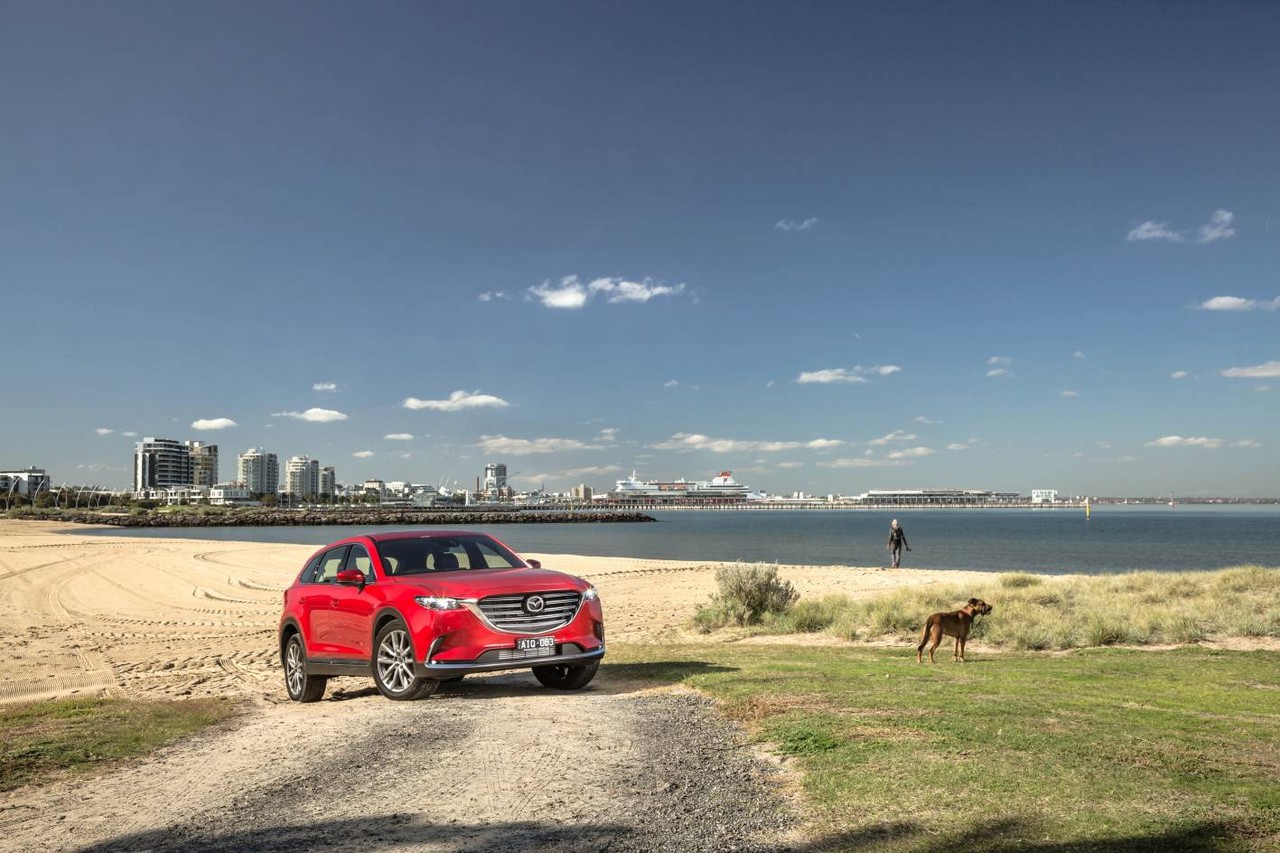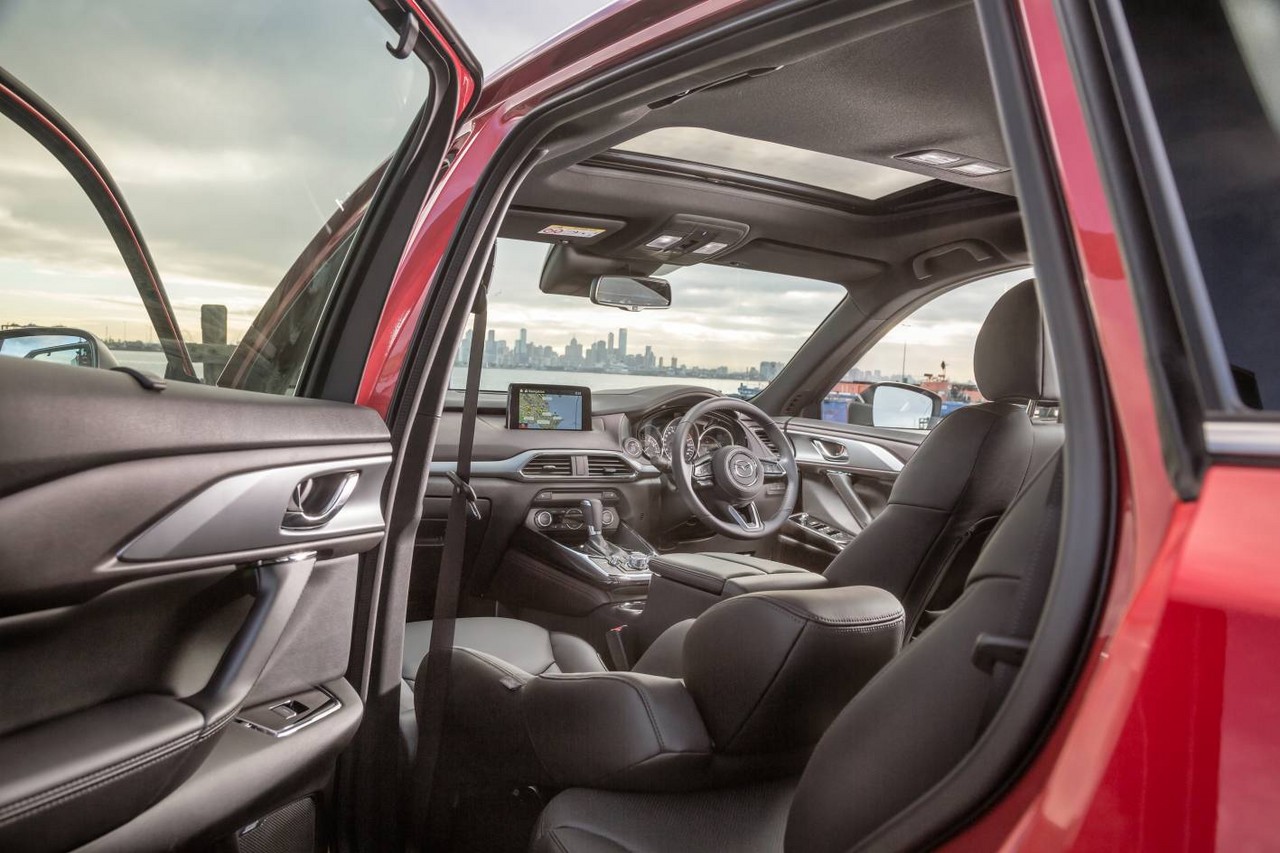
- Efficient and responsive 2.5-litre turbo petrol engine
- Refined six-speed automatic transmission
- Comfortable ride and impressive body control
- High standard of interior fit and finish
- Five star safety rating and AEB fitted as standard
- A-pillar has been moved rearwards to improve visibility…
- … but reduces cabin length
- Front and second row headroom inferior to TB CX-9
- Third row seats only suitable for children
- For FWD, steering wheel kickback over bumps
- Road noise
- At high rpm, 2.5-litre turbo engine is noisy and vibrates the floorpan
- No Apple CarPlay or Android Auto smartphone integration prior to September 2018
Overview
Released in Australia in July 2016, the Mazda TC CX-9 was a seven-seat SUV. Manufactured in Japan, the Mazda TC CX-9 was powered by a 2.5-litre turbocharged four-cylinder petrol engine and offered with front- and all-wheel drive powertrains; a six-speed automatic transmission, however, was standard for all models. Upon its release, the Mazda TC CX-9 range consisted of Sport, Touring, GT and Azami editions.
In September 2018, the Mazda CX-9 range was expanded with a range-topping Azami LE variant.
SkyActiv-G 2.5T engine
The Mazda TC CX-9 was powered by a 2488 cc ‘SkyActiv-G’ turbocharged petrol engine. Based on the naturally aspirated 2.5-litre SkyActiv-G engine , the SkyActiv-G 2.5T engine had an aluminium alloy cylinder block, an aluminium-silicon cylinder head, a forged steel crankshaft, double overhead camshafts, four valves per cylinder and a compression ratio of 10.5:1; the engine is also understood to have variable intake and exhaust valve timing (Mazda’s ‘Dual Sequential Valve Timing’ or ‘Dual S-VT’).
Significantly, the SkyActiv-G 2.5T engine featured Mazda’s world-first ‘Dynamic Pressure Turbo’ which could vary the degree of exhaust pulsation according to engine speed (in contrast to variable geometry turbochargers which adjust the speed or direction of exhaust gas flowing into the turbine). The Dynamic Pressure Turbo operated as follows::
- At low engine speeds (below 1620 rpm), the size of the exhaust ports was reduced by closing a series of valves located just before the turbine which drove the turbocharger – this reduced interference between exhaust pulses and enabled the turbocharger to spool up quickly, up to a maximum pressure of 1.2 bar (17.4 psi); and,
- At higher engine speeds, the secondary valves opened to allow a greater volume of exhaust gas to pass through the turbocharger.
The SkyActiv-G 2.5T engine also had:
- Mazda’s ‘i-stop’ which enabled it to shut down when the vehicle was stationary in traffic to minimise fuel consumption;
- Mazda’s ‘i-ELOOP’ which used a variable-voltage alternator to increase its output of electrical energy when the driver lifted their foot off the accelerator. The energy was then stored in a double-layer capacitor and used to power the vehicle’s electrical systems, thereby reducing fuel consumption;
- A 4-3-1 exhaust whereby the exhaust from the middle two cylinders (2 and 3) was joined into a single port, while the exhausts from the outer cylinders (1 and 4) had their own ports. The three ports merged at the entrance to the turbocharger’s exhaust side such that there was one pulse arriving every 180 degrees of crankshaft rotation. As a result, the exhaust pulses were kept separate for maximum energy extraction and each exhaust pulse was harnessed to extract residual exhaust gas from the adjacent ports; and,
- A cooled exhaust gas recirculation (EGR) system which allowed the engine to maintain a stoichiometric air:fuel ratio (14.7:1) over a wider output range.
Over the combined ADR 81/02 test cycle, fuel consumption was 8.4 litres per 100 km for the front-wheel drive CX-9 and 8.8 litres per 100 km for the all-wheel drive CX-9. The Mazda TC CX-9 could run on standard unleaded (91 RON) or with E10.
| Variant | Engine | Drive | Trans. | Peak power | Peak torque |
|---|---|---|---|---|---|
| Sport, Touring, GT, Azami |
2488 cc turbo petrol I4 | FWD, AWD |
6sp auto | 170 kW at 5000 rpm | 420 Nm at 2000 rpm |
| Azami LE | 2488 cc turbo petrol I4 | AWD | 6sp auto | 170 kW at 5000 rpm | 420 Nm at 2000 rpm |
i-ACTIV all-wheel drive (AWD) system
The Mazda CX-9 was available with Mazda’s ‘i-ACTIV’ all-wheel drive system. In normal conditions, the system directed all of the engine’s torque to the front wheels for maximum fuel economy. The system, however, used 27 different sensors to monitor vehicle and road conditions. If the front wheels began to lose traction, or a loss of traction was anticipated, an electronically controlled coupling could engage to direct up to 50 per cent of the engine’s torque to the rear axle (i.e. for a 50:50 front:rear torque split). The i-ACTIV system could also direct power to the rear wheels when cornering to reduce understeer.
Dimensions and body
Compared to the Mazda TB CX-9 , the Mazda TC CX-9 was 1 mm longer (at 5075 mm), 33 mm wider (1969 mm), 19 mm taller (1747 mm) and had a 55 mm longer wheelbase (2930 mm); ground clearance was 220 mm. Unusually, however, the A-pillar was moved back by 100 mm to create a longer looking bonnet.
Significantly, the front-wheel drive Mazda TC CX-9 was around 90 kg lighter than its predecessor (for a circa 1850 kg kerb weight), while the all-wheel drive models were around 130 kg lighter (circa 1930 kg kerb weight). Mazda also sought to make the TC CX-9 quieter by using additional sound deadening mats and increasing window thickness to 4.8 mm. According to Mazda, interior noise levels were reduced by 12 per cent when travelling at speeds of 100 km/h. In September 2018, Mazda announced that noise, vibration and harshness (NVH) had been further reduced by:
- Tuned mass dampers;
- Vibration-reducing powertrain mounts;
- Changes to the second-row seat rails;
- Increased steering column rigidity;
- A revised headliner; and,
- The use of the steering wheel-mounted airbag as a tuned-mass damper.
Luggage capacity for the Mazda TC CX-9 was 230 litres with the rear seats in position, though this increased to 810 litres when the third row seats were folded down and cargo was filled to the roofline (VDA method). Furthermore, the Mazda CX-9 had a braked towing capacity of 2000 kg.
Suspension
Like the Mazda TB CX-9 , the TC CX-9 had MacPherson strut front suspension and independent, multi-link rear suspension (both with coil springs, gas-filled dampers and anti-roll bars).
From September 2018 deliveries, the following changes were introduced to improve ride comfort:
- A redesigned attachment point between the steering’s outer ball joint and steering knuckle (for a more neutral feel);
- Higher rigidity front hub bearings and steering mounts to improve steering responsiveness;
- Lower friction dampers;
- Recalibrated springs;
- Urethane top mounts for the rear dampers; and,
- ‘Optimised’ vertical spring characteristics for the engine mounts.
Safety equipment
Standard safety equipment for the Mazda CX-9 included dual front airbags, front side airbags, full-length curtain airbags (i.e. for front, second and third row occupants), ABS, electronic brake force distribution, brake assist, electronic stability control, traction control and front seatbelts with pre-tensioners and load limiters.
As standard, the Mazda CX-9 was fitted with the following ‘i-ActivSense’ active technologies:
- Smart City Brake Support (SCBS): used a windscreen-mounted near infra-red sensor and operated at speeds between 4 km/h and 30 km/h (and reverse speeds of 2 km/h to 8 km/h). SCBS could detect when the vehicle was rapidly approaching an obstacle and autonomously apply the vehicle’s brakes to reduce the severity of an imminent collision from six metres away. In August 2017, the operating range for Smart City Brake Support (Forward) was extended to 80 km/h;
- Advanced Blind Spot Monitoring (ABSM): used a 2.4 GHz radar on each side of the CX-9 to detect vehicles up to fifty (50) metres away. If detected, an LED icon on the relevant door mirror would illuminate and an alert would sound; and,
- Rear Cross Traffic Alert (RCTA): could monitor approaching traffic which may cross the vehicle’s path when the driver was reversing. If detected, a warning tone would sound.
Beyond this, the Mazda CX-9 Azami added:
- Smart Brake Support (SBS): operated at speeds from 15 km/h to 145 km/h and would monitor the distance of the vehicle ahead. If there was a high risk of impact, the brakes would be primed for faster response. If the driver failed to act, the brakes would be applied automatically to prevent or reduce the severity of the collision;
- Distance Recognition Support System (DRSS) and Forward Obstruction Warning (FOW): used a millimetre wavelength radar to measure the distance between the CX-9 and the vehicle ahead, and showed this information in a five-step display that encouraged the driver to adjust their speed to maintain a safe distance. If the distance to the vehicle ahead decreased such that evasive action was necessary, audible and visual warning signals were issued (FOW);
- Mazda Radar Cruise Control (MRCC) with Stop and Go function: used a millimetre wavelength radar to monitor traffic ahead and operated at speeds between 30 km/h and 145 km/h. MRCC could control the engine and brakes to 1) maintain a safe distance from vehicles ahead and 2) where safe to do so, maintain the target speed set by the driver;
- Lane-Keep Assist System (LAS): provided corrective steering if the vehicle was drifting from the centre of its lane;
- Lane Departure Warning (LDW): provided steering wheel vibrations to alert the driver if they began to stray from their lane; and,
- High Beam Control (HBC): allowed drivers to keep their high beam headlights on and automatically dipped them when the camera detected headlights from oncoming vehicles or tail-lights. HBC also switched to low beams at speeds below 30 km/h; and,
- Driver Attention Alert (DAA): operated at speeds above 65 km/h and monitored driver inputs (such as steering) for signs of fatigue. If detected, a visual warning would be issued. DAA would also issue an alert if the CX-9 had been driven for two consecutive hours.
From August 2017, the Mazda CX-9 GT and Azami were equipped with Traffic Sign Recognition (TSR) which could interpret traffic sign information and relay it to the driver.
Brakes
The Mazda TC CX-9 had 320 mm by 28 mm ventilated front brake discs and 325 mm by 11 mm solid rear discs.
ANCAP testing
In ANCAP testing , the Mazda TC CX-9 received a five star adult occupant protection rating with a score of 35.87 out of 37. In the frontal offset test, protection of the front occupants was generally rated as good, though protection of the driver’s chest and lower legs was rated as adequate (i.e. a slight risk of serious injury). In the side impact and pole tests, however, maximum points were awarded.
Features: Mazda TC CX-9 Sport
Standard features for the Mazda CX-9 Sport included 18 x 8.0J alloy wheels with 255/60 R18 108H tyres, MZD Connect with satellite navigation and a seven-inch colour touchscreen, a six speaker sound system with auxiliary input jack (3.5 mm), USB input, Bluetooth mobile phone connectivity and audio streaming, Internet radio integration, black cloth upholstery, three-zone climate control air conditioning, cruise control, LED headlamps, halogen daytime running lamps, a rear view camera, rear parking sensors, a leather-wrapped steering wheel and gear shift knob, 60/40 split fold second row seats, 50/50 split fold third row seats, remote central locking, power adjustable mirrors, power windows, a height and reach adjustable steering wheel, an auto-dimming rear view mirror, push-button start, height adjustable front seats, 12 volt power socket (cargo area), reading lights, illuminated vanity mirrors, LED tail-lamps, a trip computer and an immobiliser.
From September 2018, the Mazda CX-9 was equipped with Apple CarPlay and Android Auto smartphone integration.
As standard, the Mazda CX-9 was fitted with a temporary spare wheel (17 x 5.5J with a 185/80 R17 tyre).
Features: Mazda CX-9 Touring
Compared to the CX-9 Sport, the Mazda CX-9 Touring was further equipped with an eight-inch colour touchscreen, black leather upholstery, six-way power adjustable and heated front seats, LED front fog lamps, dusk-sensing headlamps, rain-sensing wipers, and second row seats which had a centre armrest and USB input.
Features: Mazda TC CX-9 GT
Relative to the CX-9 Touring, the CX-9 GT added 20 x 8.5J alloy wheels with 255/50 R20 105V tyres, a Bose sound system with twelve speakers and digital radio tuner (DAB), front parking sensors,proximity key (i.e. keyless entry), heated mirrors, power sunroof (sliding and tilt), power-operated tailgate, driver’s seat memory settings and LED reading lights.
The Mazda CX-9 GT and Azami were also fitted with Mazda’s ‘Active Driving Display’, a full-colour head-up display which projected information – such as vehicle speed, navigation directions and cruise control settings – onto the windscreen.
Features: Mazda TC CX-9 Azami
In addition to its safety equipment, the Mazda CX-9 Azami was distinguished by its adaptive LED headlamps and LED daytime running lamps.
From September 2018, the Mazda CX-9 Azami was equipped with ventilated front seats, a 360 degree View Monitor, a seven-inch LCD that was mounted to the instrument panel, a heated steering wheel, a windscreen de-icer, and a frameless interior rear-vision mirror.
Features: Mazda TC CX-9 Azami LE
The Mazda CX-9 Azami LE was released in Australia in September 2018. Compared to the Mazda CX-9 Azami, the CX-9 Azami LE was further equipped with Chroma Brown nappa leather seat upholstery, a hand-crafted box stitched steering wheel, decorative wood panels, centre console ambient lighting (LED) and a unique overhead console design.
August 2017 update
In August 2017, the Mazda CX-9 benefited from the following updates –
- G-Vectoring Control (GVC): fitted as standard, GVC slightly reduced engine torque as the steering wheel was turned – usually by 0.01 g or less – to the front wheels to generate a small shift in load to the front axle. According to Mazda, this torque reduction improved cornering response by optimising the vertical load on each wheel;
- Noise reduction measures: included reducing the height difference between the rear end of the roof moulding and tailgate, increasing the thickness of the noise-absorbing material on the underside of the headliner, fitment of noise-insulating material on the back of the boot side trim, higher-density fibres for the floor mats and an additional insulation layer for the ceiling liner. According to Mazda, these measures improved the clarity of voices in the second and third row by approximately five per cent;
- Second row seats: could lean forward 33 degrees when the seat was slid forward to increase the space between each second row seat and the rear wheel housing. The angle of operation for the walk-in lever on the shoulder of each second row seat was also reduced from 58 degrees to 51 degrees, and the amount of force required to operate it was reduced by 25 per cent. Furthermore, the slide rail retainers for the second row seat were changed from metal to plastic to reduce slide resistance;
- Third row seats: a second top tether point was added so that child or booster seats could be mounted to all second and third row seats;
- Power adjustable driver’s seat: gained a tilt function that adjusted the height of the cushion’s front edge;
- CX-9 GT and Azami: the outer seats in the second row gained a seat heating function; and
Mirrors: auto-power folding mirrors were fitted as standard across the range.
As noted under ‘Safety equipment’, the operating speed range for Smart City Brake Support (Forward) was increased from 4-30 km/h to 4-80 km/h, and the CX-9 GT and Azami were fitted with Traffic Sign Recognition.
Brochure and specifications
Related links
